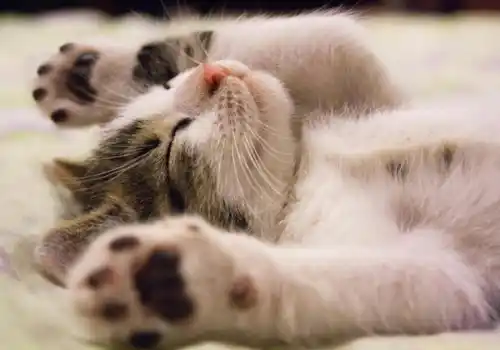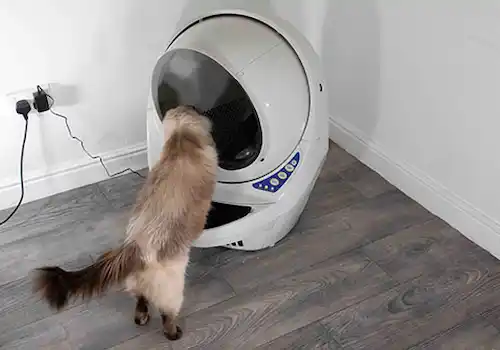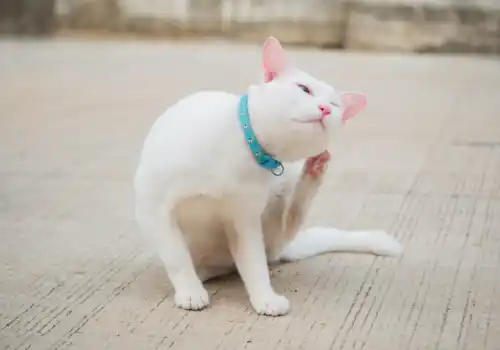You can keep your indoor cat entertained by providing them with entertainment and stimulation. Read more about how you can entertain your indoor cat.
Cats have instinctive needs to express certain behaviours, and if indoor life means that they cannot do these activities, they're likely to become stressed.
Stress may be expressed in different ways, depending on the individual. One cat may tend to hide, while another will urinate in inappropriate places. It's your responsibility to provide for behavioural needs, which would normally be obtained in the great outdoors. These include the need to hunt, the ability to retreat and hide, the pleasure of climbing and, in general, the need for a cat to have a sense that he is in control of his own activities.
Indulging in an intense physical activity and having somewhere to 'chill out' are especially important when space is limited and/ or cats have to share their indoor environments with people and pets they may find difficult to tolerate, for whatever reason. Of course for the best of both worlds you could enclose your outside space with a cat run or secure fencing, at least in part, so that your cat could have access to the outdoors.
Indoor cats can be prone to weight gain if they don't have enough opportunity to exercise and lead a sedentary life. Obesity makes cats more prone to diseases such as diabetes. Combat this by making an effort to spend time each day playing with your cat using interactive toys, including balls and fishing rod-style toys that he can chase and jump for.
Choose a food that is best suited to your cat's individual needs. Your vet will be able to advise you on this. There are premium foods designed for indoor-only cats, and you can also buy 'light' foods intended for cats with a tendency to put on weight. Bored cats will tend to eat more, so it's a good idea to add some kibble to treat ball toys, taken out of his daily food ration. It'll encourage him to play a little more and 'work' for his food.
Another option is to scatter feed - distribute a handful of kibble in a room for him to find. This will help provide interest for him and relieve boredom too. If you feed wet food, do be careful in the hottest of weathers, as the food will become stale quicker. Take it up after your cat has eaten, but if he likes to pick through the day, put dry food down as described above. Be aware also, that cats tend to eat less when it's hot - and can be lethargic on the hottest days.
An annual visit to the vet is also advisable to keep an eye on your cat's health. Take his or her advice on vaccinations, and also flea and worm treatments since indoor cats can still pick them up. Microchipping is a must because there may come a day when your cat escapes from the house. Remind family members to keep windows and doors closed with an indoor-only cat!
How can I entertain my indoor cat?
-
If your cat has to spend extended periods alone each day, keep a radio playing or play relaxing music for him.
-
Get him some new toys, especially toys that he can play with by himself, avoiding toys with elastic or string which he could get himself tied up in. Hide some of them around your home for him to find.
-
A ping-pong ball in a bath (when dry!) is a fun toy to chase.
-
Rotate those toys! Removing an old toy and giving it back to him a few days later ensures that the toy has novelty value and he's more likely to play with it.
-
Cats love cardboard boxes, especially if you make new entrance holes or peep holes. Flick a scrunched-up ball of paper for him to play with inside, or pop treats inside for him to find.
-
Bring in new items to show him - fallen feathers for him to sniff, paper carrier bags with the handles cut for him to play in, and so on.
-
Minimize confinement as much as possible - freedom to roam is very basic to cats. If you don't already have one, get a climbing tree or tower. Remember, vertical space is as important to cats as horizontal space, and cats love to be high up.
-
Consider allocating part of his regular dry diet to hide around the house. He'll enjoy the search and reward activity.
-
Set time aside everyday to give your cat some one-to-one attention. It could be combined with a grooming session or a game with an interactive toy.
-
Vary your playing routine with him. One day focus on a fishing rod-style toy, the next try a torch light against a wall for him to chase.
-
Provide lots of refuges in elevated positions - such as multi-tiered cat activity centres and safe access to tops of furniture and shelves -throughout the home, as well as adequate toilet facilities (one litter tray per cat and one spare), several beds and scratch posts.
-
Feeding the birds and hanging mobiles or ornaments in the garden could also help to keep him entertained, provided he has a perch near a window.
Personal space is extremely important to a cat's psychological wellbeing. Forcing too many cats to share a small area, will result in behavioural, and even physical problems as each one competes for their own territory. Each one must have an area to which they can escape.
The perfect house to keep your indoor cat entertained:
-
Cats love to run up and down stairs.
-
Large windows will give your cat a view across the garden and provide opportunities to sunbathe.
-
Provide lots of space for your cat's toys and for him to play in and race around at high speed!
-
A cat-proofed fenced garden will give your cat safe access to the outdoors. Be wary of low roofs or sheds, which could give a neighbour's cat a way into the garden and then be trapped.
-
Leave a radio or TV on for company.
-
A food specially designed for indoor cats can help prevent weight gain and the formation of hairballs.
Play and toys to keep your indoor cat entertained
Behaviourist Sarah Ellis says it's important to give your cat as much control as possible over his environment. Her research has revealed some interesting, albeit 'typical of cats' some might say, results. For instance, a study of cat toys found a hair band attached to thread was more popular with cats than a ball in a track toy.
Sarah explains: "The success of this [hair band on a thread] is most likely to be due to its movement triggering behaviours similar in expression to the final parts of the cat's hunting sequence - the chase and/or the pounce, whereas the track toy did not allow the cat to pounce or capture the ball."
The same could be said for a laser which does not allow the cat to complete the hunting sequence holding the potential to trigger frustration and related behaviours.
Companions - are two cats better than one?
There are differing opinions as to whether an indoor cat needs a feline companion. When once it was considered a must, Sarah Ellis says it is not a blanket recommendation she would ever make. "Free-living cats tend to exist in social groups of related females and even then these groups only form where there is readily available food to support everyone.
"Since we are very social beings where companionship is really pertinent to us, we may think of cats in the same way, but it is not often the case. Introduction of unrelated individuals can often be difficult. Also if two cats do not consider themselves of the same social group, living together in an indoor-only environment where they have limits on the amount of physical space they can put between themselves could be potentially quite stressful and is often some of the factors involved in resultant behaviour problems.
"If someone is thinking of having more than one cat, I may advise them to consider siblings from the same litter rather than getting another unrelated one later on."
"While it is evident that further studies into environmental enrichment are needed, there are definitely improvements we can make to our indoor cats' lives."
Sun worship for your indoor cat
Help your cat to enjoy the sun by giving him access to sunny windowsills and placing his beds in any particularly sunny spots. A tall piece of cat furniture positioned next to a window or patio doors can make an ideal sunbathing place. Your cat may not be going out into the sunshine but that doesn't mean he won't be affected by the heat from the sun or radiator. He may moult a little more than usual so if necessary, groom him more often to remove loose hairs and prevent furballs. He is also likely to drink more so ensure he has a constant supply of fresh, clean water. You could also consider fitting window screens to allow him a supply of fresh air.








